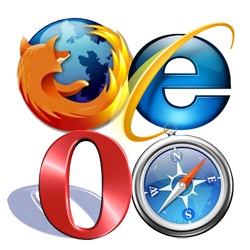Technical Aspects & Quality
You may be asking yourself why you should end up going with one website development over another. Often times price is ultimately a deciding factor, and rightly so. While I offer the opportunity to keep your costs comparatively low, I also offer other technical aspects and a quality to website design that is hard to find elsewhere at any reasonable price.
First, the websites I develop are designed to validate by W3C (World Wide Web Consortium) standards.
The W3C is a web development group that basically sets the standard for web design. While anyone can fire up a freely downloaded web editor and create a page, most often such design practices are wrought with bugs and coding errors that cause a website to be horribly skewed or even completely unviewable by some browsers. By following the W3C standards, a developer and a viewer knows that the website is designed to the highest standard, allowing full accessibility to the largest portion of viewers and preventing a complete meltdown of the website to any one viewer. For a more detailed explanation of the importance of valid web coding, please click on the W3C (World Wide Web Consortium) link above.
I also create and utilize graphics that are not overly-large in size, thereby keeping all pages easily accessible even by users without high-speed broadband internet access. People with dial-up access can view your webpage without waiting and waiting for it to load. However, even with the use of web graphics and styling, the major focus is on content - your message.

Accessibility
I use a developmental method with an emphasis on accessibility. A web design is at its best when it incorporates those little "extras" that make it stand out - from a simple color-changing menu when the mouse is rolled over, to a full-blown picture gallery with thumbnail images. Having these extra areas means nothing, however, if they cannot be seen by viewers.
Websites that exclusively use Flash or Javascript elements fail to acknowledge that not every viewer has the capability of displaying that content. Such content requires a plug-in (Flash) or requires scripting to be enabled on the viewer's web browser (Javascript), which is not always the case. And what good are those elements if they can't be seen? That is why I only use unobtrusive Javascript and never use Flash-required content. (To clarify, Flash media can be used, just not to the point that a user must have Flash in order to view your site content.)
The elements that I produce primarily utilize PHP as the scripting language, with all scripting done on the server and requiring nothing of the viewer. This means that all of the "extras" are achieved in a method leading to a website whereby each viewer's experience is exactly what you want it to be.
I also create each design with a three-step quality control method to ensure that your viewers can experience the correct design regardless of which web browser they use. After conforming the design to W3C standards, I check the layout in Firefox and apply fixes until it renders correctly. I then do the same thing for Internet Explorer 8, covering the two most widely used web browsers in the world. Finally, I check and apply fixes so that the web design also renders correctly in Internet Explorer 7, which is sometimes used on those computers that have yet to upgrade to IE8. This process ensures that your website looks great under all conditions.
Fluid Design
Finally, I like to utilize a fluid website design. A fluid design differs from a fixed design in that it will always fill the viewer's entire screen, no matter how big or how small (within reason, and specially designed to be best viewed within the most common range of screen resolutions). This website is fluid - try adjusting your screen resolution or simply resizing your browser window to see how the page automatically moves to fit the screen. A fluid design is a more professional looking style, created to set your website apart and adding yet another element of full accessibility.

